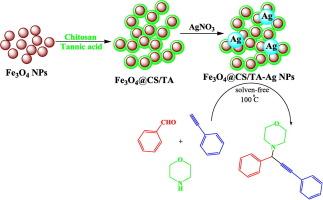壳聚糖-单宁酸复合改性磁性纳米粒子负载的银纳米粒子作为生成丙胺的可回收催化剂
IF 5.4
3区 化学
Q1 CHEMISTRY, INORGANIC & NUCLEAR
引用次数: 0
摘要
在这项研究中,我们描述了用壳聚糖和单宁酸(CS/TA)的混合复合材料(CS/TA)制备和测试了一种新型的磁性材料,该材料在涂覆的Fe3O4 NPs上修饰银NPs。采用TEM、FESEM、EDX、图谱分析、VSM、XRD和ICP-OES等方法对制备的Fe3O4@CS/TA-Ag NPs材料进行了分析。TEM图像显示了固定的Ag NPs,在修饰的Fe3O4 NPs表面约30-50 nm处。研究了Fe3O4@CS/TA-Ag NPs作为催化剂的性能,通过将炔、胺和醛相结合的反应(称为A3偶联)制备丙胺。Fe3O4@CS/TA-Ag NPs催化剂通过磁场回收,具有足够的稳定性,可以在连续6次循环中重复使用,活性降低最小。在改进的工艺条件下,不同芳香醛与苯基乙炔和啉结合制备了多种PAs,收率达到82 ~ 98%。本文章由计算机程序翻译,如有差异,请以英文原文为准。

Silver nanoparticles supported over chitosan-tannic acid composite-modified magnetic nanoparticles as recyclable catalyst for creation of propargylamines
In this study, we described the production and testing a new type of magnetic material that contains silver NPs adorned on coated Fe3O4 NPs, using a mix composite of chitosan and tannic acid (CS/TA). The produced Fe3O4@CS/TA-Ag NPs material was analyzed using various methods like TEM, FESEM, EDX, map analysis, VSM, XRD and ICP-OES study. The TEM images shown the immobilized Ag NPs, measuring about 30–50 nm over the surface of modified Fe3O4 NPs. The performance of the Fe3O4@CS/TA-Ag NPs as catalyst was examined for the preparation of propargylamines by using a reaction that combines alkynes, amines, with aldehydes, known as A3 coupling. The Fe3O4@CS/TA-Ag NPs catalyst was recycled through a magnetic field and applied adequate stability for reuse over 6 consecutive cycles with minimal decrease of activity. Different aromatic aldehydes were combined with phenyl acetylene and morpholine to create various PAs under improved parameters with good yield (82–98 %).
求助全文
通过发布文献求助,成功后即可免费获取论文全文。
去求助
来源期刊

Inorganic Chemistry Communications
化学-无机化学与核化学
CiteScore
5.50
自引率
7.90%
发文量
1013
审稿时长
53 days
期刊介绍:
Launched in January 1998, Inorganic Chemistry Communications is an international journal dedicated to the rapid publication of short communications in the major areas of inorganic, organometallic and supramolecular chemistry. Topics include synthetic and reaction chemistry, kinetics and mechanisms of reactions, bioinorganic chemistry, photochemistry and the use of metal and organometallic compounds in stoichiometric and catalytic synthesis or organic compounds.
 求助内容:
求助内容: 应助结果提醒方式:
应助结果提醒方式:


